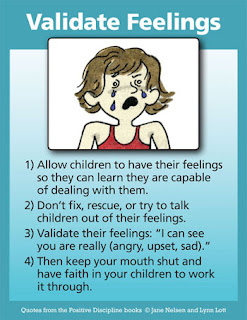I found Closet Listening be one of the easiest and yet most
difficult tools to use. Easy, because all you really need to do is sit with
your child and not say anything. I found this difficult, because it’s not my
personality to just sit and not initiate the conversation. In fact, even with
my own children, I feel uncomfortable with silence. When I sat with them
quietly—it felt almost like I
was ignoring them. Greyson 6-years old even asked me, “What’s wrong?” I
responded by saying, “I just want to sit by you and be with you.” That was even
strange for him.
We
ended up putting a puzzle together. I made a conscious effort to not initiate
any conversation and just waited to see what would come up. This is when I
discovered how difficult it is to listen without judging, defending, or
explaining.
He asked me if we could go to the
store to buy some more toys. He went on, and on about how he didn’t have enough
toys, and we definitely needed to buy at least a new puzzle.
Rather than feeling annoyed and irritated that our conversation, yet again, was about what he wanted or wanted to buy, I just nodded my head and made a few loving gestures like rubbing his hair and giving him a wink. To my surprise, by not engaging, I stopped feeling irritated and annoyed. Of course, it’s not like him to give up that easily. I simply redirected him with our puzzle. When he still didn’t drop it—I told him that he should continue to save his allowance and we’ll go in the future.
Rather than feeling annoyed and irritated that our conversation, yet again, was about what he wanted or wanted to buy, I just nodded my head and made a few loving gestures like rubbing his hair and giving him a wink. To my surprise, by not engaging, I stopped feeling irritated and annoyed. Of course, it’s not like him to give up that easily. I simply redirected him with our puzzle. When he still didn’t drop it—I told him that he should continue to save his allowance and we’ll go in the future.
The easiest and most meaningful
conversations happened through closet listening when we were driving. I picked
Greyson up from school, turned off the radio. Instead of saying, “How was your
day?” I said, “I missed you today” and then waited to see where the
conversation went from there. It was definitely a challenge to give advice or
my opinion about all the different things that happened. For example, Greyson
shared that his friends let him play kickball and four square, but never gave
him a turn. As a parent—you
can only imagine what it was like to NOT give my opinion or theory about what I
thought happened. Instead, I
incorporated other tool cards of validating his feelings followed by curiosity
questions. I then reminded him that I had faith in him to work it out with his
friends.
I believe that a common mistake
that parents make (like me) is giving too much advice, or trying to protect
their children from pain and suffering—all
in the name of love. What I’m trying to practice is just being there for my
boys. I want to show them unconditional love and support by listening; followed
by true faith that they will survive, thrive, learn and grown strong from ALL
of their life experiences; and that it’s NOT my job to protect them from
feeling sad or disappointed.


















